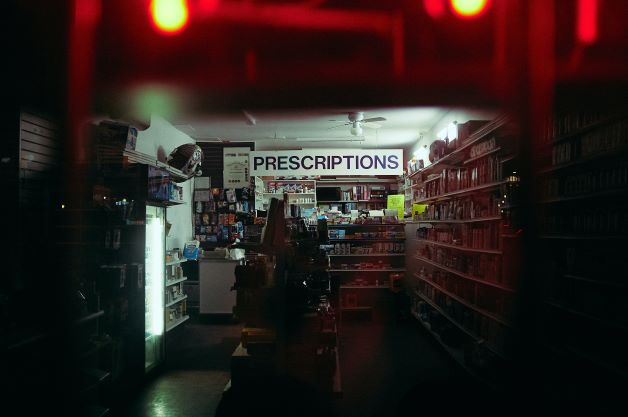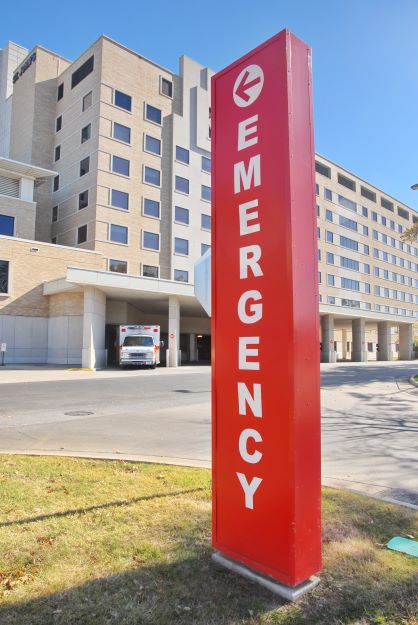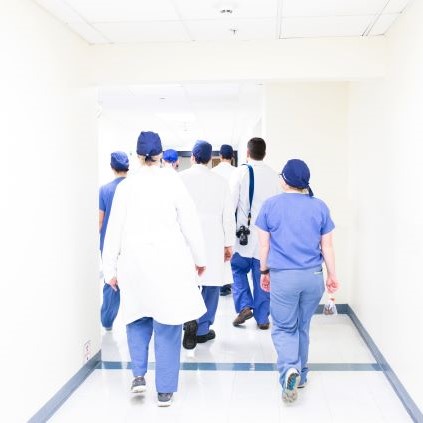What’s the Story?
Clinical Pharmacist: Not Your Typical Pharmacist
Friends and family frequently ask me what I do at the hospital as a clinical pharmacist. Because of this, I realized that most folks don’t know much about the hospital pharmacist’s job. For example, did you know that in a hospital, no medication reaches a patient that has not been approved by a pharmacist?
Curious about the work we do or thinking about a change of career path? Then this “behind the scenes” look at the role of clinical pharmacist is for you. However, if you wonder about the life of a community pharmacist check out this overview from Roseman University.
Common Types of Pharmacists

When it comes to pharmacists, the folks in a community pharmacy are the most common. This means the professionals who work in national pharmacy chains, quietly counting pills, represent the general understanding of a modern pharmacist. In fact, 50 percent of working pharmacists practice in the community setting according to the bureau of labor statistics (BLS). These folks are also called retail pharmacists and dispensing pharmacists. I have sometimes heard them referred to as druggists by the elderly and chemists by people from outside the United States.
The second largest pharmacist group practices in healthcare systems. This includes clinical pharmacists, also generally called hospital pharmacists and institutional pharmacists. This group makes up 27 percent of working pharmacists according to the BLS. The remainder of pharmacists practice in other settings like medical offices, the pharmaceutical industry, government, and universities.
Navigating This Article
Coming up, I’ll described how a typical day is organized. Then, we will take a look at additional responsibilities that are constantly managed during a work shift. Lastly, we will talk about specialized duties that change from hospital to hospital.
A Day in the Life
Clinical Pharmacist’s Working Hours

Hospitals are open 24/7, so hospital pharmacists typically work around-the-clock in eight to ten hours shifts. Clinical pharmacist are hospital pharmacists with additional responsibilities and usually works during daytime hours when there are more support staff available. The number of patients that clinical pharmacists take care of varies a lot depending on the hospital.
Coming On Shift
Hand-Off:
A report from the pharmacist leaving is given to the pharmacist starting. We get information about issues that came up during the previous shift, complex patients, and medications that need to be monitored, made, or obtained during the day. With a good game plan, I can prepare for the rest of the day and ensure that the most challenging patients get enough attention.
Beginning of the Shift
Cleaning and Sterilization:
This sounds basic, however when it comes to sick patients, we take no chances. Some people are sick enough that if they were exposed to any common bacteria or virus, it would be dangerous for them. For this reason, we use special equipment and cleaning procedures. The pharmacy and the device we use to make the medications that are injected into patient’s bodies, called a compounding hood, are cleaned to an incredible standard.
Medication Review:
I also call this ‘pre-rounding’. During this process we review every patient in our care. If a new patient is admitted, we look up why they are here and what factors are keeping them in the hospital. For each patient, I like to imagine that the reason they are staying in the hospital is related to a pharmaceutical. In this way, I force myself to consider how optimizing their drug therapy can get them out of the hospital sooner and safer.
Patient Rounds:
Rounds are the part of the day when the medical team meets to make a day-plan for each patient. Things discussed are what brought the patient into the hospital and what the team hopes to accomplish on behalf of the patient. It is during this process that we bring up concerns for patients’ medications and ask questions of the treatment team. They do the same in return. By bringing together our specialized knowledge we can maximize our individual contribution to each patient. Team synergy is hard at work.
Break
Yes, even robot-like pharmacists need a break sometimes. I’m always hungry, so it’s my chance to get some food. I try to get away to a quiet place to eat. However, I stay on duty during all my rest breaks. In the event of a code, or medical emergency, we need to be available to provide lifesaving drugs to critical patients. So, I stay near a computer to continue to verify orders and answer drug information questions from the healthcare team.
End of the Shift
Medication Reconciliation:
During this process, we review the medications a patient was taking before they came into the hospital. I have a conversation about medications with each person and answer any drug questions they may have. This prevents duplicating medications the patient already tried at home, prevents drugs interactions, and catches dosing errors that may have occurred outside the hospital. It also helps the medical team make more thoughtful decisions about medications during a patient’s hospital stay. More and more states are requiring this to be part of a pharmacist’s duties.
Medication Education:
Sometimes patients are discharged from the hospital with medication devices that are complicated to use. With any extra time during our day, we speak with patients and go over how to use these complicated medication devices to prevent errors and make sure they can use them safely during an emergency.
Going Off Shift
Hand-Off:
The shift ends the same way it began, with a hand-off. Once again, we discuss issues that came up during the day, challenging patients, and medications that need to be monitored, made, or obtained. This way, we make sure both the patients and pharmacist are set up for success.
Continuous Work
Pharmacists Must Always Do Three Things
In addition to everything mentioned above, the next three tasks are done continuously throughout the day. This is the bread and butter of the work pharmacists do.
Order Verification
In the hospital setting, prescriptions are referred to as orders. Every medication that a patient may take while staying in the hospital needs an order. Pharmacists must review every order that is written to make sure that the medication and the dose are correct. We must also check for any interactions between other drugs or diseases. Order verification is the top priority of pharmacists. But why is that?
Humans are imperfect. Everyone understands this. The same is true for humans who work in healthcare. Unfortunately, medication errors cost the lives of many people every year. Our key role is to correct the medication mistakes created by physicians who write orders and prevent medication mistakes when nurses give these medications. Once an order has been perfected and reviewed, it is considered verified.

Medication Dispensing
Once an order has been verified it needs to be accessed by a nurse or caregiver. In modern hospitals, some medications are stored in medication dispensing machines. If the medication is not in a dispensing machine, it is prepared by the pharmacy. This is especially true for complicated medications such as liquid or injectable products. As always, perfection is the goal. I make sure the medication has a proper expiration date, is the correct strength, and right amount before sending it to be used by a patient. If it is an injectable mediation, extra safety steps are required because these medications have a higher risk of causing harm if they are prepared incorrectly.
Drug Information Requests
Healthcare providers such as physicians and nurses have many questions about drugs. In hospitals, pharmacists provide drug information to our colleagues. For example, physicians often ask about the correct dose for a medication or how long it will stay in a patient’s body. Nurses often ask which medications can be given at the same time. Healthcare providers want to make sure they are not going to cause a drug reaction.
This is my favorite part of being a pharmacist. I love doing research, learning new things, and sharing interesting information.
Other Responsibilities
A Clinical Pharmacist’s Work Depends on the Hospital
Much of the workload a clinical pharmacist has depends on the where we work. A pharmacist’s duties are not well established like they are for nurses and physicians. This means our work can have a lot more variability. Here are a few duties I have been responsible for at various hospitals.
Medical Emergencies:
- Critical patients and medical codes require on-the-spot care. A clinical pharmacist is called to these urgent situations to provide their services. They will advise physicians with selecting and dosing emergency medications. Then they will mix and measure medications to be given. Importantly they monitor all medications the patient has received to make sure that no harm comes to the patient from an overdose or a dangerous combination.
Total Parenteral Nutrition (TPN):
- When patients are unable to eat either because of an illness or because of a surgery, they are fed via a continuous injection. This is known as a TPN infusion and it contains an entire day’s worth of calories and nutrients. My task in this setting was to manage the ingredients of this complex medication by ordering blood tests and making sure the patient was given enough nutrition to heal by adjusting the amount every day.
Anticoagulation:
- A blood clot is a clump of blood that blocks nutrients and oxygen from moving around the body. This is a serious medical condition and if it happens medications to prevent blood clots are needed. These are called anticoagulants or “blood thinners”. Pharmacists monitor patients on anticoagulants by ordering blood tests and changing the dose to make sure they are using the safest amount of medication.
Therapeutic monitoring:
- Some medications have a narrow therapeutic index, meaning too much is dangerous but too little doesn’t do anything to help a patient heal. Medications to fight infections are a good example. In these cases, pharmacists monitor medications by ordering blood tests and adjusting the dose to ensure the patient stays on track safely.
Inventory management:
- A pharmacy can not run without drugs. At a smaller pharmacy with limited support staff, pharmacists make sure that they have enough medication to meet the needs of their patients. They check to make sure their products are not expired or recalled. They also order replacements and obtain rare medications as needed.
Regulatory Agencies:
- Pharmacy practice is the most heavily regulated industry. This means there are many visits by state and federal agencies to make sure the pharmacy follows all rules and regulations to protect the safety of the public. These visits often require a pharmacist to meet with the regulator and provide any information they may be looking for to complete their audit.
Final Thoughts
Summing Things Up
So that’s it in a nutshell. Busy behind the scenes is the best way I would describe the role of a clinical pharmacist. If this article was interesting, in the future I may write another regarding the pros and cons of the job.
My Experience as a Clinical Pharmacist
Over the years I’ve had the opportunity to work in several hospitals. Although there’s a large amount of difference between each place, the skeleton of the work remains similar. Please keep in mind that this is based on my personal experience. I’d love to hear about your experiences too. Feel free to point out any differences or similarities in the comments section below.
References
Pharmacists : Occupational outlook handbook. U.S. Bureau of Labor Statistics. https://www.bls.gov/ooh/healthcare/pharmacists.htm#tab-3. Published September 13, 2021. Accessed April 11, 2022.
As always, feel free to contact us with any questions or for additional information.


Great content! I had no idea that so much goes on behind the scenes or that you could be called into action in an emergency. This article is well organized and easy to understand. What about a day in a life as a medical writer? 🙂
Thank you so much for the positive feedback! Happy to know you liked the article. I am a fan of your idea for a future article! I’ll let you know as soon as it’s done.
Very interesting piece. Great writing style, looking forward to more, especially regarding the pro and cons of the job.
I’m so grateful you took the time to provide feedback, thank you! I’m glad my writing is easy to relate to. We’re really all in this together.